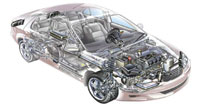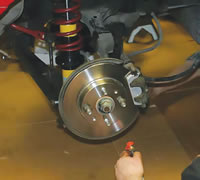 TYPICAL MAINTENANCE AND REPAIR
TYPICAL MAINTENANCE AND REPAIRThe key to a car running at its best is basic maintenance. Keeping up with fluid changes, tire checks, filter changes and other services will help avoid bigger and more expensive repairs. Over time, some car parts and components wear out or become damaged. Being aware of your car will help you address any issues before they become bigger problems.

ENGINE PERFORMANCE
Service to maintain engine performance, sometimes known as a tune-up, keeps your engine working hand-in-hand with the rest of your car’s powertrain. This is how optimum car performance is achieved.
WHY DO I NEED THIS SERVICE?
A well-tuned engine delivers the best balance of power and fuel economy and produces the lowest level of emissions. Modern engines compensate for worn parts to a degree, giving you the sense that everything is fine with your car. Keeping your engine tuned will restore your car to its normal operating state, and contribute to the overall efficiency of the engine and emissions system. The Environmental Protection Agency (EPA) says a well maintained car is more fuel efficient, produces fewer greenhouse gas emissions, is more reliable and is safer!
TYPICAL SERVICE
1.Based on spark plug type the replacement interval can range from 30,000 to 100,000 miles.
2.Replace any other ignition system and/or emissions system parts that may be needed or recommended.
3.Replace the fuel and air filters.
QUESTIONS TO ASK
1. How often does my car need a tune-up?
2. Are there other services that need to be performed at this time?
3. If the “Check Engine” or “Service Engine Soon” light comes on, is it the same as saying it’s time for a tune-up?
OIL, FILTERS AND FLUIDS 
Critical parts of your engine are lubricated, cleaned and cooled by your car’s oil and filter. Other specifically formulated fluids are used for the operation and protection of systems and components such as brakes, cooling, power steering, automatic and manual transmissions, and transfer cases. Your car may also be equipped with a variety of filters including those for the transmission, fuel system and interior ventilation.
WHY DO I NEED THIS SERVICE?
Periodic oil and filter changes help keep your engine clean on the inside. Dust, metallic shavings, condensation and even antifreeze can contaminate motor oil. Additives, which break down over time, are also subject to contamination. Other fluids in your vehicle may require periodic replacement. For example, the majority of automatic transmission failures are heat related, and automatic transmission fluid breaks down rapidly when subjected to high temperatures. Your car owner’s manual may specify periodic flushing and filling of the brake hydraulic system because contaminated brake fluid may lead to corrosion and other problems in the hydraulic system, especially on vehicles with anti-lock brakes (ABS).
TYPICAL SERVICE
1. Oil level should be checked frequently and changed every 3,000 -5,000 miles or as directed in the owner’s manual.
2. If you regularly make short trips in your car, drive in stop and go traffic, idle for extended periods, drive in dusty or dirty air conditions, tow a trailer or live in a cold-weather region, stay with the 3,000-mile/three month schedule because you are considered a severe driver.
3. Many car manufacturers recommend extended oil drain intervals for some drivers.
4. For automatic transmissions, brakes, power steering and axles, vehicle specific fluids should be used.
5. Coolant should be changed periodically as specified in the owner’s manual. Coolant fluid type and interval schedule will vary by vehicle.
QUESTIONS TO ASK
What fluids will you be checking?
Is the oil you’re putting in my car the right type for the way I drive?
Is an oil filter change included with this service?
When should I get my next oil change?
How often should my fluid levels be checked?
Will my car’s instrument panel alert me if fluids are low?

BELTS AND HOSES
Many experts recommend replacing belts, radiator and heater hoses at specific intervals to prevent your car from breaking down. Losing a belt today can mean big trouble for the engine because serpentine belts are used on most engines to turn the water pump, alternator, power steering and air-conditioning compressor.
If the serpentine belt fails or breaks, the engine will fail to run and you may be stranded. Older cars use V-belts for various accessories and failure of this belt could also strand you. A blown hose could result in an overheated engine and can cause additional engine damage.
WHY DO I NEED THIS SERVICE?
It’s not easy to know the true condition of a belt or hose by its outward appearance, because most belts and hoses fail from the inside out. Rubber hoses can become hard and brittle, deteriorating with age and exposure to heat, causing the hose to split, blister or leak. Belts also break down with heat, mileage and age. Every time a belt passes around a pulley, it bends. Flexing produces heat that causes the rubber to harden over time. In addition, if the belt is loose or slips, the wear process can be accelerated.
TYPICAL SERVICE
Hoses should be inspected at each oil change for leaking, cracks, discoloration or any other visual sign of wear. Squeezing the hose can also indicate need for replacement. Any hose that feels rock hard or mushy should be replaced.
Hoses should always be replaced with a new radiator or water pump installation.
Clamps should be replaced when new hoses are installed.
V-belts should be inspected for looseness, cracks, frays or glazing. Typical replacement is every three to four years or 40,000 to 50,000 miles.
The serpentine belt system should be inspected for looseness and signs of wear. Tensioners and pulleys should be inspected for noise and wear. Typical replacement is 60,000 to 90,000 miles. The system may also require replacement of a tensioner or pulley.
Replace timing belts based on the interval specified in the owner’s manual, typically between 60,000 and 90,000 miles. During a timing belt service it may be recommended to replace tensioner, pulleys, and water pump.
QUESTIONS TO ASK
1. What’s the difference between a V-belt and a serpentine belt?
2. Why does my V-belt have notches?
3. Do you recommend replacing the water pump and tensioners while replacing my belt(s)?

BRAKE SERVICE
The brake system is your car’s most important safety system. Never put off routine brake inspections or any needed repair.
WHY DO I NEED THIS SERVICE?
Brakes are a normal wear item for any car. Eventually, they’re going to need to be replaced for both performance and safety reasons. Don’t let your brakes get to the “metal-to-metal” point, which usually means more expensive rotor or drum replacement. Your car owner’s manual might specify periodic flushing and filling of the brake hydraulic system. Contaminated brake fluid may lead to corrosion and other problems in the hydraulic system, especially on cars with anti-lock brakes (ABS).
TYPICAL SERVICE
1. Have your brake pads and shoes, drums and rotors, master cylinders, wheel cylinders, brake hoses, calipers, brake hardware and brake fluid inspected.
2. Depending on the condition or thickness of the drums or rotors, resurfacing or replacement may be necessary.
3. The parking brake should also be checked for proper operation and adjustment. In some cases, the parking brake shoes/pads may need replacement.
QUESTIONS TO ASK
1. Is there anything I can do to help the brakes on my car last longer?
2. Are there any related services my car needs while this service is being performed?
3.What does the brake warning light mean on my car’s dashboard?
